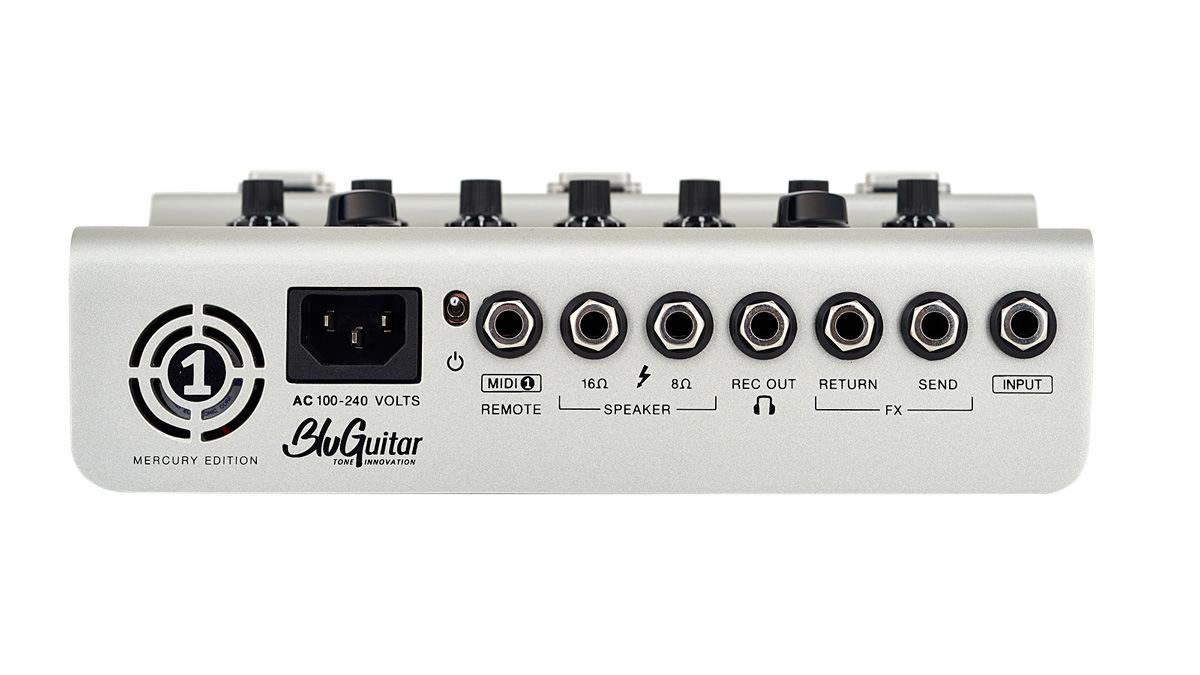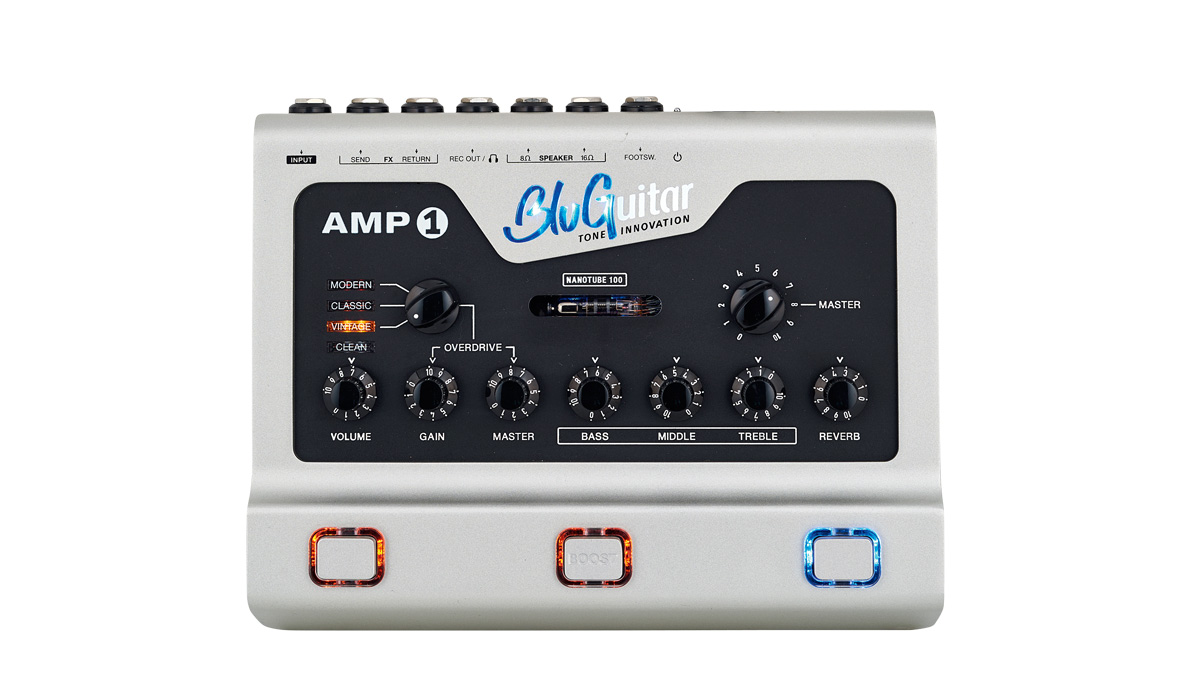MusicRadar Verdict
The improved Mercury Edition of the Amp1 is an even more compelling choice than before.
Pros
- +
Simple, direct analogue functionality with stunning tone.
- +
Massive flexibility if you need it, yet keeps things simple if you don’t.
Cons
- -
The Remote1 and Looperkit add-ons are quite expensive extras, though in fairness they aren’t essential to get playing here.
MusicRadar's got your back
While the big head is still alive and kicking, there’s been a renewed trend toward small units in recent years, fuelled by a number of different developments.
Guitar-friendly Class D power amps, next-generation digital modelling, and the modern quiet stage (which banishes backline and replaces it with in-ear monitoring) have all moved the goalposts for modern guitar amplification in the professional environment. Some exciting and innovative products have arrived on the scene as a result, but only a few have really taken up the challenge and hit the bullseye. One of the earliest was the BluGuitar Amp1, which we looked at back in late 2014.
BluGuitar is the brainchild of Thomas Blug, whose dual career as a top performer and designer/collaborator with Hughes
& Kettner gives him a unique approach to product design. While the majority of the competition employs digital modelling technology, the Amp1 is mostly analogue, with a solid-state preamp driving a sub-miniature twin triode valve that powers a beefy 100-watt class D output stage, and a smooth digital reverb in the sidechain. It’s proved to be a singular success. Now, after four years, Blug has rebooted the Amp1 with a revoiced version called the Mercury Edition. Does it still excite as much as the original? Let’s take a closer look...
Build
Externally, the new Amp1 doesn’t appear to be any different, apart from the words ‘Mercury Edition’ under the fan grille indicating this is the updated version. It’s compact and very light, with a footprint about the same as a standard iPad. The electronics live inside a robust stamped aluminium sub-chassis, with a thick aluminium faceplate that curves over at the top and bottom edges. The controls are logically laid out, with a voice/channel selector switch on the left and a big master volume knob on the right, either side of the Amp1’s so-called Nanotube, a sub- miniature Russian twin triode.
Underneath are controls for the Clean channel volume, gain and master for the three overdrive channels and a familiar three-band EQ, with a level control for the digitally-modelled spring reverb. Below these, on a raised ledge, are three illuminated footswitches. One toggles between the Clean channel and whatever drive channel has been selected; the other two operate boost and reverb functions. There’s also a pre-set mode that lets you put your choice of channel/boost/reverb on each button.

On the rear panel there’s a single input jack, with a pair of send/returns for the effects loop. Other connections include a speaker-emulated line-out that can also drive headphones, eight- and 16-ohm speaker jacks, and a socket for a footswitch. This is where the Amp1 begins to show off some of its prodigious versatility. You can use it on the floor like a regular stompbox with the integral switches – in which case you’ll need a long speaker lead. Or you can sit it on top of your cab and use a conventional latching double footswitch to toggle between drive and clean, and boost on/off.
Want all the hottest music and gear news, reviews, deals, features and more, direct to your inbox? Sign up here.
The attention to detail includes a recess underneath the chassis, so the Amp1 can straddle carry handles, and there are optional magnetic locking studs to hold it in place, if needed. If you need further options, a dedicated foot-controller called Remote1 uses MIDI to access all four channels, plus boost, reverb and the effects loop. Remote1 also adds a second master volume and an adjustable power soak.
As for storage, you can save complete patches including the Clean channel’s volume and drive channel’s gain settings, with up to 36 slots in nine banks of four. There’s more: a MIDI out socket sends patch-change commands to other MIDI- enabled devices, and there’s an optional expansion module called the Looperkit, which provides four mono true bypass effects loops that can be programmed independently for each patch. All of these extras are handled seamlessly by the Amp1 using a standard guitar lead, which also powers the Remote1 foot-controller, keeping your stage layout as neat as possible. Clever stuff, indeed.
The valve-driven 100-watt power amp is still its biggest weapon. It’s almost unreal to hear so much tone coming from this package
There’s more flexibility on the left-hand chassis side, where you’ll find six Custom Control trimpots that tweak the Clean channel tone, plus the volume and tone of the Modern and Vintage channels and the boost level. Two small toggle switches control the Amp1’s integral noise gate, with soft, hard and off settings, and switch the built-in effects loop from series to parallel mode. On the underneath of the unit, one last switch pre-sets the loop level for stompboxes or semi-pro rack devices.
This is a good-looking and robust product with a unique style. It’s intuitively simple on the surface but with huge flexibility if needed, and it’s definitely built to last.
Sounds
The revoiced Mercury Edition definitely extends the range of the original Amp1, without travelling too far from the original sounds, which were already superb. The Clean channel has a pleasing springy response, which can be tweaked using the custom control to flatter humbuckers and single coils alike, with rich harmonics and a treble response that can be bright but never shrill or tiring to the ear. The Amp 1’s tone controls don’t interact like most guitar amps’ (turning up a treble control usually dips the middle frequencies and vice versa); here, each frequency is defined separately, making it lightning-fast to dial in.
The three overdrive sounds cover the full gamut of vintage, classic and modern distortion, from 60s Marshall Plexi crunch to the thick harmonic filth demanded for modern metal. Again, all three drive channels have been revoiced, with a tighter response, particularly so on the Modern channel, which can really punch through, especially with the noise gate running. Despite all channels sharing the same EQ, there’s enough range on the trimpots to balance each voice for optimal response, leaving the bass, mid and treble controls free to work as a solid master tone network.
Flexibility aside, the Amp 1’s valve-driven 100-watt power amp is still its biggest weapon: plugged into a good 4x12 it sounds huge, with all the dynamic response you’d expect from valves and volume to spare. It’s almost unreal to hear so much tone coming from a package weighing just over a kilo.
The revoiced Mercury edition extends the range of the original, without travelling too far from its superb original sounds
BluGuitar has already done a stellar job of making the Amp1 flexible and portable, so ultimately it’s down to your ears to decide whether the revised sounds still cut the mustard. Based on our experience of the old and new models, we’d say the Mercury Edition is definitely a step up, with increased definition that makes it even easier to slot the Amp1 into a mix, and an excellent new reverb that’s as good as any you’ll find in or out of a studio.
The immediacy of analogue and the freedom from multiple menu levels and software apps make the Amp1 a real player’s tool - just like a great Les Paul or Strat, it’s down to you, your ears and your fingers to get the best from it, and the Amp1’s best sounds can challenge guitarists at any level, from beginner to pro.
All in all, the new, improved Mercury Edition of the Amp1 is an even more compelling choice than before, although the price has risen by about 13 per cent in the past four years. However, for what it can do, we still think it’s brilliant value for money and just as worthy of our top award as it was the first time around.
